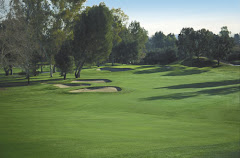While I don't want to make this Blog all about the weather, I feel that the weather it one of the single biggest limiting factors to the condition of the golf course. Last post I talked about frost and how we have been affected by it. Well it never fails, two days after that last post we have had a high pressure system set in over the southwest of the US and it has been non stop wind and heat. Last January we had 9 inches of rain for the month of January, so far this year we have had 0. And no significant chance of rain is in the forecast. While this dry month has been great for playing golf, the drought situation that we face in the Southwest portion of this country continues to worsen.
The US National Weather Service Climate Prediction Center recently (January 8, 2009) posted an important Climate Prediction Update. Based on lower water temperatures in the central and east-central Pacific Ocean, climatologists are now calling for a La Nina condition in the Northern Hemisphere for Spring, 2009.
For the U.S., this signals above-average precipitation in the Ohio and Tennessee Valleys, and below-average precipitation in the South, especially the southwest and southeastern states. Warmer weather in the southern U.S. and cooler weather in the Pacific Northwest are also likely outcomes. This is bad news for southern states that have been suffering with a drought for the past several years.
Outside the U.S., a La Nina conditions usually results in high rainfall over Indonesia, and below-average precipitation over the central and eastern equatorial Pacific.
For more detailed information on El Nino and La Nina, see this very good website, Frequently asked questions about El Nino and La Nina.
At this point water rationing could be mandated as early as this summer. Valencia CC does have a plan in place to reduce water consumption if mandated and will be done so in a way that protects that playability and turf health of greens, tees and fairways. If we get to this point I will have a more detailed posting on how this will be implemented and what to expect. Until then, conservation will be key and a rain dance can only help.
Monday, January 19, 2009
Tuesday, January 6, 2009
Winter is here!

Our first frost of the season was on December 14th, about 3 weeks later then normal. Since this day we have made up for the lack of frost by having frost on 21 of the last 24 days. Two of the days with out frost it was raining.
Frost occurs when the soil surface is 32 degrees or below, causing dew to freeze on the turf. The ice crystals that form are lovely to look at, but are also the most serious hazard to the health and appearance of turf during the winter months. Frost produces a silvery sheen on turf as is illustrated in the photo above.
Frost by itself does not necessarily cause damage to turf. However, when weight is applied to frosted turf in the form of foot or vehicular traffic, damage will result. This is because frost transforms turf from a s soft, springy surface to a fragile, brittle surface that cracks when pressure is placed on it.
All types and heights of turf can be damaged by frost, not just putting greens.
Golf cart traffic on frosty turf results in damage that appears 2-3 days later. Walking on frosty greens also produces foot shaped patterns of brown, dead turf. In both cases, turf is slow to recover, leaving unsightly brown areas for weeks or even months.
Frost is frequently an early morning problem that is relieved once the sun comes up and air temperatures rise. Once frost crystals melt, turf is safe for foot and vehicular traffic.
There is really only one way to avoid frost damage, and that is to avoid all traffic until it has melted.
Subscribe to:
Comments (Atom)







